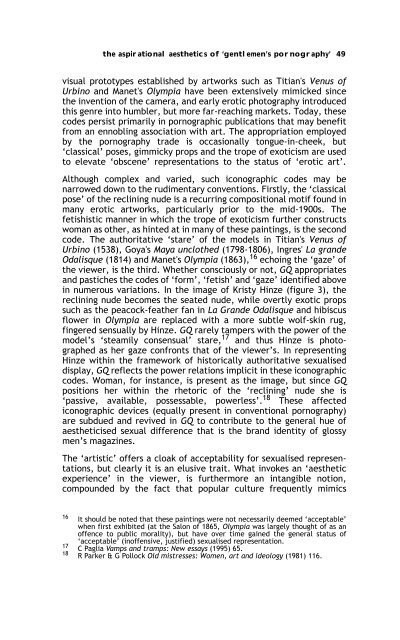Sex, Gender, Becoming - PULP
Sex, Gender, Becoming - PULP
Sex, Gender, Becoming - PULP
Create successful ePaper yourself
Turn your PDF publications into a flip-book with our unique Google optimized e-Paper software.
the aspirational aesthetics of ‘gentlemen’s pornography’ 49<br />
visual prototypes established by artworks such as Titian's Venus of<br />
Urbino and Manet's Olympia have been extensively mimicked since<br />
the invention of the camera, and early erotic photography introduced<br />
this genre into humbler, but more far-reaching markets. Today, these<br />
codes persist primarily in pornographic publications that may benefit<br />
from an ennobling association with art. The appropriation employed<br />
by the pornography trade is occasionally tongue-in-cheek, but<br />
‘classical’ poses, gimmicky props and the trope of exoticism are used<br />
to elevate ‘obscene’ representations to the status of ‘erotic art’.<br />
Although complex and varied, such iconographic codes may be<br />
narrowed down to the rudimentary conventions. Firstly, the ‘classical<br />
pose’ of the reclining nude is a recurring compositional motif found in<br />
many erotic artworks, particularly prior to the mid-1900s. The<br />
fetishistic manner in which the trope of exoticism further constructs<br />
woman as other, as hinted at in many of these paintings, is the second<br />
code. The authoritative ‘stare’ of the models in Titian's Venus of<br />
Urbino (1538), Goya's Maya unclothed (1798-1806), Ingres' La grande<br />
Odalisque (1814) and Manet's Olympia (1863), 16 echoing the ‘gaze’ of<br />
the viewer, is the third. Whether consciously or not, GQ appropriates<br />
and pastiches the codes of ‘form’, ‘fetish’ and ‘gaze’ identified above<br />
in numerous variations. In the image of Kristy Hinze (figure 3), the<br />
reclining nude becomes the seated nude, while overtly exotic props<br />
such as the peacock-feather fan in La Grande Odalisque and hibiscus<br />
flower in Olympia are replaced with a more subtle wolf-skin rug,<br />
fingered sensually by Hinze. GQ rarely tampers with the power of the<br />
model’s ‘steamily consensual’ stare, 17 and thus Hinze is photographed<br />
as her gaze confronts that of the viewer’s. In representing<br />
Hinze within the framework of historically authoritative sexualised<br />
display, GQ reflects the power relations implicit in these iconographic<br />
codes. Woman, for instance, is present as the image, but since GQ<br />
positions her within the rhetoric of the ‘reclining’ nude she is<br />
‘passive, available, possessable, powerless’. 18 These affected<br />
iconographic devices (equally present in conventional pornography)<br />
are subdued and revived in GQ to contribute to the general hue of<br />
aestheticised sexual difference that is the brand identity of glossy<br />
men’s magazines.<br />
The ‘artistic’ offers a cloak of acceptability for sexualised representations,<br />
but clearly it is an elusive trait. What invokes an ‘aesthetic<br />
experience’ in the viewer, is furthermore an intangible notion,<br />
compounded by the fact that popular culture frequently mimics<br />
16 It should be noted that these paintings were not necessarily deemed ‘acceptable’<br />
when first exhibited (at the Salon of 1865, Olympia was largely thought of as an<br />
offence to public morality), but have over time gained the general status of<br />
‘acceptable’ (inoffensive, justified) sexualised representation.<br />
17<br />
C Paglia Vamps and tramps: New essays (1995) 65.<br />
18 R Parker & G Pollock Old mistresses: Women, art and ideology (1981) 116.
















